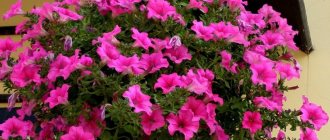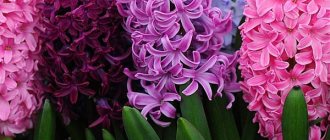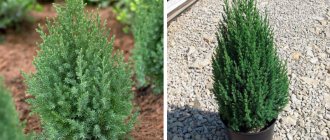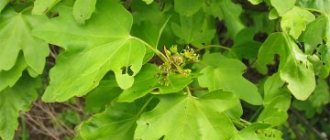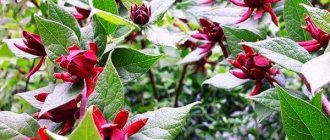Many gardeners prefer to grow not only healthy vegetables and tasty fruits on their plots, but also ornamental plants that decorate the garden landscape. These plants include the exotic Japanese maple - a wonderful representative of the botanical world, with a bright spreading crown.
The tree attracts with its original appearance, however, the question arises whether this exotic beauty will be difficult to care for. To dispel doubts, in this article we will talk about the features of growing and planting Japanese maple in our climate: we will find out how to plant the plant and how to care for it.
Description and features of Chinese and Japanese red maple
Japanese maple is an ornamental tree originally from Japan. Today, about 100 of its different species and varieties are known: such a rare variety allows you to choose the most suitable variety and leaf color for any landscape design. This material will tell you about planting and caring for lilacs.
Japanese maple
The height of the Japanese maple can be from two to ten meters, and has a characteristic bright color of foliage. Leaf colors can be as follows:
- green;
- red;
- yellow;
- pink
Other, rarer shades of color are also possible: it depends on the plant variety.
The shape of the plant is interesting and unusual: the Japanese maple has a lush, spreading, wide crown, somewhat reminiscent of a palm tree. This is an ideal plant for autumn: with its wonderful variety of bright foliage, it can dispel any blues, lift your spirits, and inspire creativity.
In the northern regions, unfortunately, street growing of Japanese maple is very difficult: only if you place the plant in a large tub, which can be put away in a house or barn for the winter.
Acer negundo (American or Californian maple)
This maple is native to North America, but has long since formed its own vast range in Europe, actively displacing local species and even becoming a threat to local ecosystems in some places. But we are now talking about its cultural forms, which are grown in our gardens.
This maple is very winter-hardy, unpretentious to soil conditions, but grows better in fertile fresh soils in well-lit places. It has a high growth rate and is resistant to air pollution. The leaves are complex pinnate and can consist of three, five, seven or even nine leaves. They resemble the shape of an ash leaf - hence the Russian specific name.
Unfortunately, compared to other types of maples, ash-leaved is not very durable, and is also characterized by the fragility of its branches and superficial root system.
Ash-leaved maple Flamingo (Flamingo)
This maple's foliage ranges from hot pink to creamy pink when it blooms, then turns green with an irregular pink or white border and pink spots, and in the fall the green part of the leaf turns light yellow.
The decorative effect is enhanced by regular spring pruning and is not lost when grown in partial shade.
An adult tree grows up to 3-6 meters. Shrub forms are often grown. The crown is spherical, neat, dense. The bark is light gray, smooth, young growths are light green. The leaves are medium-sized, complex-pinnate, thin, smooth.
Ash-leaf maple Sensation (Sensation)
Young leaves are reddish-brown and light bronze-orange, becoming bronze-green in summer, and yellow and orange-red in autumn, but not all over the tree at once.
The variety is very drought-resistant and undemanding to soil; it loves the sun.
An adult tree grows up to 6-15 meters, the growth rate is moderate. The crown is compact, symmetrically spherical. The bark is gray-brown, the branches are green to purple, and the trunk is often branched. The leaves are medium-sized, complex-pinnate, thin, smooth.
Of course, these are not all the colorful decorative deciduous maple species that you can place in your garden. If you are interested in this culture, also take a closer look at Japanese, gray, Far Eastern, silver, false sycamore, palmate, and fan maples - perhaps it is among them that you will find your future favorite.
Varieties
Today, the following varieties of Japanese maple are the most decorative and popular.
Shirasawa fan
This is a low variety of tree: it reaches a height of only one and a half meters. It has decorative wide leaves, a beautiful and bright orange-yellow hue.
Shirasawa
Bloodgood – red leaf maple
This is a truly unique variety, since the tree in this case has inky black leaves.
Bloodgood
Beni Kava
This variety of Japanese maple has original bright red foliage and ruby-colored bark. You can imagine how decorative the plant looks.
Beni Kava
Katsura
An interesting variety that has double-colored leaves: in summer they are green, and by autumn they change color to golden.
Katsura
Red-leaved trees for small cottages
In a small southern dacha, especially in an East Asian style, a single specimen of red-leaved fan maple (Acer palmatum) .
Fan maple f. atropurpureum, photo by the author. Fan maple 'Beni-Kagami'. Photo from forums.botanicalgarden.ubc.
Its varieties with burgundy and red leaves are mesmerizing, causing delight and admiration! This:
- f. atropurpureum - leaves are deeply lobed, red-purple, in autumn - bright red, as if on fire;
- 'Beni-Kagami' - 8 m high and wide, weeping, leaves 5-lobed, red-purple;
- 'Bloodgood' - 5 m high and wide, 5-lobed leaves, red-purple, red fruits;
- 'Burgundy Lace' - 4 m high, 5 m wide, leaves 5-lobed, dark purple;
Fan maple 'Bloodgood'. Photo from growerssolution.com. Fan maple 'Burgundy Lace'. Photo from onlineplantguide.com.
- 'Chitoseyama' - 2 m high, 3 m wide, leaves 7-lobed, deeply cut, crimson-green, purple-red in autumn);
- 'Crimson Queen' - 3 m high, 4 m wide, arched shoots, openwork leaves, finely cut;
Growing
Although the procedure for planting a Japanese maple seedling is simple, it does, however, require knowledge of some nuances. Let's talk about these nuances in more detail.
To plant a plant correctly, you need to prepare in advance:
- the seedling itself: healthy and strong;
- compost and peat for fertilizer.
First, you should dig a hole: its parameters should be approximately twice the span of the plant’s roots. If the seedling was purchased in a pot, then it must be carefully removed from this container. Unravel the roots of the plant: also very carefully, without tugging.
Add peat and compost to the prepared hole. Place the seedling in the hole, sprinkle soil on top, and tamp it down.
Video: planting a tree
In the video - planting a Japanese maple:
Around the seedling, form small sides of soil along the diameter of the root circle. This will make it easier to water the plant, as the water will not be able to drain.
Immediately after planting a maple or decorative mulberry, water the seedling so that the roots take root faster. If the summer turns out to be very hot, the seedling will need to be watered more often and more abundantly.
Next spring, it is necessary to lay a mulch layer of soil mixed with rotten fallen leaves over the root circle of the plant. This layer will help moisture stay longer in the root circle and also protect the ground around the seedling from weeds.
You can see what the New Year's glowing trees look like in the photo.
But you can see what fast-growing hedge plants look like in the photo.
What kinds of hedge plants there are, and what they look like, this information will help you understand: https://2gazon.ru/postroiki/zabory/zhivaya-izgorod/bystrorastushhie-kustarniki.html
The photo from the article will help you understand how to make a willow hedge with your own hands.
Selection of location and conditions
If you have chosen a palmate plant for planting, then you need to prepare a shady place for it. All other types of Japanese maple prefer full sun. But, although many of the varieties tolerate direct sunlight, this does not apply to those that have double-colored leaves: in this case, the plant requires only shade or partial shade. By the way, Japanese maple is not afraid of winds and drafts, so this parameter is not important here.
As for the soil, it should be well-drained and light. The plant prefers fertile, humus-rich soil that is slightly acidic . It is important that the root system of the plant receives moisture without obstacles and in sufficient quantities. Otherwise, the leaves of the Japanese maple may turn brown from lack of water.
The plant does not tolerate lime, so the area should not be treated with this substance. If the root system of the plant comes into contact with lime, this may cause the maple leaves to begin to fall off.
It is important to know that these plants are quite heat-loving, and the harsh climate of the Russian north is unlikely to suit them. However, experienced gardeners carefully cover the tree for the winter, thanks to which they are able to grow Japanese maple even in cold winter conditions.
You may also be interested in learning about which hawthorn seedlings are best to choose for hedges.
Use in garden design
The possibilities for using maples in the countryside or in street landscaping are quite wide. They are often used as tapeworms in open areas. Dwarf forms, especially with brightly colored leaves, look beautiful in color and contrasting compositions. Shrub maples that tolerate pruning well make excellent hedges.
Interestingly, the possibilities of using plants are not limited to this. Their wood is used to make furniture and musical instruments. And the name of the Canadian sugar maple (A. saccharum) speaks for itself; maple sugar is obtained from its sap.
In the next video, an expert from the Greensad garden center will talk about how to properly propagate and plant Norway maples.
Now the time has come to get acquainted with the largest representatives of red-leaved trees - trees with purple, burgundy, violet foliage.
Red leaf maple in royal clothes, photo by the author
Without a doubt, they are spectacular solitaires that look gorgeous against any background.
Contrast of red and green, photo by the author
These are not only large maples, apple trees, plums, but also small trees that can be used in small dachas: red-leaved birches, beeches, grafted onto trunks.
Through the red leaf maple, photo by the author
In the south they love and often use cherry plum 'Pissard' in decoration.
Cherry plum 'Pissard', photo by the author
Red-leaved trees find their place in dachas of any style: maples, plums, and apple trees are in demand in Japanese gardens.
Red leaf maple in a Japanese garden, photo by the author
They are luxurious in landscape-style dachas.
Silver birch 'Purple'. Photo from the site zpitomnik.ru. Cherry plum 'Pissard' in a landscape garden, photo by the author
It is clear that dachas vary in area, and trees vary in size. Let's conditionally divide the trees into groups:
- large - more than 20 m;
- medium - 10-20 m;
- small - 5-10 m.
How to care
Let's look at the main points for caring for Japanese maple growing in the garden.
Watering
The tree needs watering. However, the plant will also not tolerate too much water. If you allow moisture to stagnate in the soil, this can lead to rotting of the maple roots. In addition to regular watering once a month during the summer season, it is necessary to organize additional watering for the maple: in this case, 15 liters of water are poured at the root at a time.
If there is a severe drought, then it is recommended to additionally spray the maple with a sprayer so that its leaves do not lose their decorative properties. But this information will help you understand how to use irrigation hoses and how to choose them.
Mulching
Mulching is of great importance for a tree: this procedure must be carried out both in spring and autumn. Use humus, tree bark, wood chips, and compost as mulch. The procedure helps the tree roots to have constant access to moisture, protects the roots from freezing in winter, and is also an additional feeding and protection against weeds.
Trimming
In the first years of its life, the plant must be pruned regularly to form a crown. And then you can no longer trim, but only remove diseased and broken branches.
But pruning is also recommended when the tree’s crown becomes very thick and has lost its former decorative appearance. In this case, thinning and pruning will help restore transparency, airiness and lightness to the crown. In addition, such thinning can protect the plant from fungal infections. Prune the plant only during the dormant period: either in early spring or before the onset of winter, when the leaves have already fallen. And here you can learn in detail about pruning Azaleas.
Top dressing
In the spring, it is necessary to apply granular mineral fertilizers under the tree, and only then cover this fertilizing with a mulch layer. Keep in mind that the mineral complex should not contain nitrogenous components, since they are not suitable for Japanese maple.
If the soil is fertile enough, then one feeding will be enough for a year. If it is scanty, then it is necessary to feed the tree again in the summer. But you can feed the plant only until August. Then the application of any fertilizers must be stopped, as the maple needs to begin to prepare for wintering.
Winter care
If the climate in your area is not mild, be sure to cover the Japanese maple for the winter. It is recommended to choose garden fleece as a covering material, as it is the warmest and softest material. If there is a lot of snow in winter, then regularly free the maple branches from this heavy precipitation.
Otherwise, the branches may not be able to withstand it and break. However, you should not touch the tree when the branches are covered with an ice crust after a thaw: in this case they are especially easy to break.
Japanese maple at home
It is possible to grow this wonderful plant at home: in this case, a dwarf maple variety is selected. The Japanese believe that the presence of this plant has a positive effect on the energy of the apartment: it brings peace, happiness, peace and prosperity.
In addition to this scientifically unconfirmed belief, scientists have already proven that Japanese maple is capable of purifying the air in an apartment, and this has a beneficial effect on the microclimate of the home. In addition, the delightful flowering of the plant will delight you from spring until late autumn.
In the video - Japanese maple in the house:
When growing Japanese maple at home, protecting the plant from pests becomes especially important, since in this case the tree grows more tender.
Reproduction
Japanese maple is usually propagated by seeds. You need to collect seeds in the fall, ideally in October. In order to properly prepare the seeds for subsequent planting, they must be stratified. To do this, the collected planting material is placed in a dry sand mixture and stored all winter in a cool place. In the spring, they are sown in a container, having previously been treated with a growth stimulator.
During the first summer, the seedlings do not stretch too much, but even at this stage it is possible to sort, leaving only the strongest and tallest specimens for further cultivation.
It is best for seedlings grown from seeds to spend their first winter indoors, still in their container. The next spring (the second spring in the plant’s life), the seedlings must be transplanted into pots of suitable size (a separate one for each specimen), and then, having grown a little more, transplanted into open ground.
If the climate or other reasons do not allow transplanting into the ground, make sure that the soil in the tub is rich in organic matter.
River maple, or ginnala
River maple, or ginnala (Acer ginnala) is a large shrub that grows up to 6 m in height with an asymmetrical crown. The dark green leaves are three-lobed, the middle part is more elongated in relation to the two lateral ones. In autumn they take on spectacular colors, ranging from bright red to purple. Miniature yellowish flowers have a pleasant aroma. Flowering begins in late spring and lasts 15–20 days.
Growing conditions: it is better to choose a bright place for planting, but the plant can also tolerate partial shade. In the shade, maple loses its decorative qualities. Due to its resistance to dust, smoke and gases, it can grow in the city. The ginnala maple grows quickly and does not suffer much after transplantation. Prefers sandy and loamy soils with a slightly acidic or neutral reaction, but tolerates heavy and clayey soils. It tolerates frosts of the Moscow region well and does not freeze. Despite the fact that river maple prefers moist soil, waterlogging is detrimental to it, so it is necessary to ensure high-quality drainage. The ginnala maple requires annual spring pruning.
Great for Japanese and Chinese gardens. River maple looks good both in a group and alone. The plant forms a dense bush and easily tolerates pruning, making it suitable for forming hedges. Often used for landscaping the banks of reservoirs. Borders look interesting - low hedges 0.5 m high. In autumn, maple will create an accent in the garden due to the expressive color of the leaves. Pairs well with snowberry, dogwood, oleaster, lilac, mahonia and barberry. It is also recommended to place the maple tree in front of the composition of coniferous plants.


